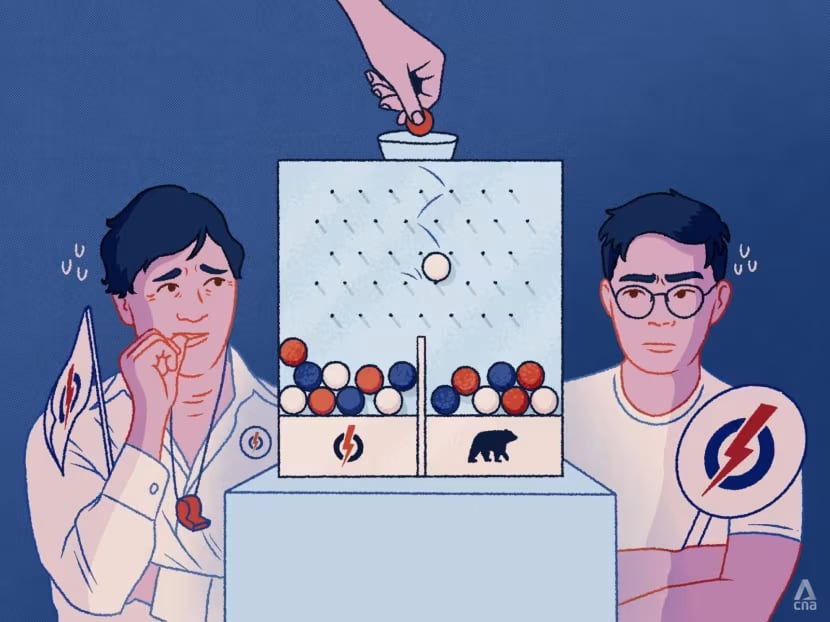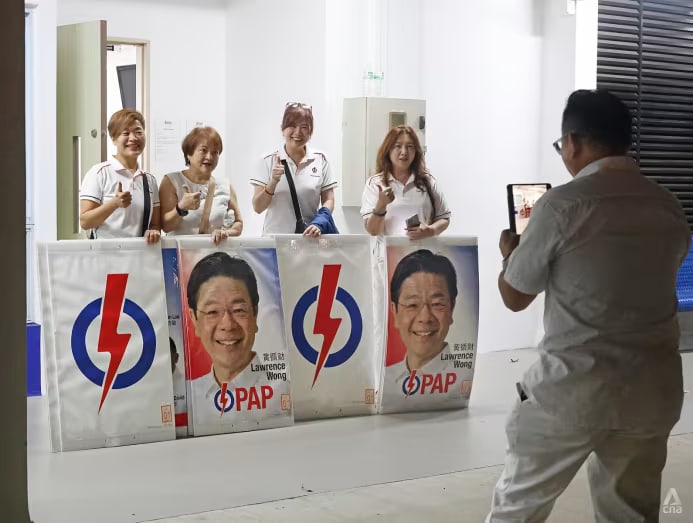GE2025: The secrets to PAP's electoral success through the eyes of party insiders


This audio is generated by an AI tool.
he People’s Action Party (PAP) may have had an uninterrupted streak of governing post-independence Singapore for almost 60 years, but this record did not stop some party activists and members from going into the recent General Election with a good amount of pessimism.
They chalked this up to the growing desire among voters for greater political contestation and diversity in parliament, based on online chatter and “coffee-shop talk” among friends.
As they entered the campaign season proper, one PAP member who was involved in the hustings in an eastern constituency said the strong support for the Workers' Party (WP) was also unnerving.
“There was a long queue to enter the Workers’ Party rally and it was really crowded, with the pitch almost full and the seated areas full,” the member said, declining to be named.
“In contrast, the PAP rally (in Tampines) was one-third full on the pitch and it did sound lacklustre. And there was quiet anxiety online and at the rally.”
Mr Eric Chin, the treasurer for the party’s branch in Boon Lay, said there was also “some nervousness” given that it was the first election helmed by Prime Minister Lawrence Wong, who is also PAP's secretary-general.
Historically, the elections immediately after a handover of leadership typically will see a dip in vote share for the ruling party.
“The stakes were high,” Mr Chin said. “The messaging about a dangerous world wasn’t just political rhetoric – we saw first-hand how global instability affects daily lives.”
In short, while they were hopeful, activists and party members on the ground were bracing themselves for all eventualities.
“The party was prepared to lose seats,” another party member of more than 10 years said. He has been involved in two election campaigns and, like some of the others who were interviewed by CNA TODAY, spoke on condition of anonymity.
Despite the initial apprehension about the election outcome, the party insiders said that the support they received while campaigning on the ground was warm.
Mr Chin said: “We also sensed that residents were still open and willing to listen. Many just wanted to be heard.”
Ultimately, on Polling Day, the seven party members interviewed by CNA TODAY said that there was a general sense of surprise. Not only was the party returned to power, but it had successfully improved its vote share and staved off any expansion by the opposition.

PAP won 65.57 per cent of valid votes, up from 61.24 per cent in 2020.
As for WP, it managed to retain the three constituencies it won in the last election, but its vote share in the places it contested dipped slightly by 0.45 percentage points to 50.04 per cent.
One unnamed PAP member helping with the campaigns in the east said: “For some, like Ang Mo Kio GRC, the results were not surprising. For others, especially the ones reported to be hotly contested areas, we were surprised by the victories, even if they were small.”
Ang Mo Kio Group Representation Constituency (GRC), helmed by Senior Minister Lee Hsien Loong, was handily won by PAP with healthy margins in several past elections.
In the hours after all the results were announced last weekend, political pundits pointed to voter discernment and the party’s successful messaging as key contributors to PAP’s successful campaign.
However, speaking to PAP activists who helped carry the party message to the masses on the ground, the picture is more nuanced. They highlighted three prominent strategies that they believe helped to deliver the strong mandate that the party ultimately garnered.
These were:
- Focusing resources and attention on the hot spots in the eastern and north-eastern parts of Singapore
- Refraining from personal attacks to focus on big-picture issues
- Doubling down on the incumbency advantage by highlighting municipal and constituency issues
SAVING FIREPOWER FOR THE EASTERN FRONT
With WP, the only opposition party with elected seats in the previous parliament, known to be focusing on eastern Singapore for its expansion plans, PAP leaders directed more attention and resources towards the east, party activists said.
“From the ground level, it did feel like resources and attention were being calibrated across constituencies. The East saw tighter contests, so naturally, more energy flowed there,” Mr Chin said.
Mr Inderjit Singh, a former PAP MP, told CNA TODAY: “I think the PAP was more worried about the WP winning another GRC and it focused all its firepower on the east side. It knows that once lost, it would be very difficult to win back a constituency.”
On the ground, this focus on the east manifested in a few ways.
One, the ruling party kept its cards closer to its chest when it came to the east – line-ups for most other GRCs were unveiled way ahead of those for eastern constituencies – and even then, some last-minute shuffles happened.
For instance, Deputy Prime Minister Gan Kim Yong was shifted to Punggol GRC on the morning of Nomination Day itself, a move that Mr Wong explained was necessary due to the retirement of Senior Minister Teo Chee Hean in the east, but which was widely seen as an electoral manoeuvre to secure the hotspot for PAP.
Dr Felix Tan also pointed to past elections where the PAP targeted Dr Chee Soon Juan, chief of the Singapore Democratic Party (SDP), for attacks.
During the 2020 election, after a televised debate where Dr Chee had brought up the government's population policies and claimed that the incumbent party "toys with the idea of bringing our population to 10 million", PAP swiftly issued a statement saying that this was a falsehood.
PAP said the population issue, which formed the basis of SDP's campaign, "renders the campaign pointless and calls into question the integrity of the whole party".
It then went on to refer to an incident in 1996, where Dr Chee had “refused to apologise for his use of wrong data on healthcare subsidies at a parliamentary select committee”, before comparing him to a leopard that never changes its spots.
Asked about the possible risks of the strategies deployed such as holding back their punches when dealing with the opposition, Dr Felix Tan said that the choices made were ultimately “for the better” and worked in PAP's favour.
“Because going for the jugular, as you’ve seen in previous elections, didn’t bode well for PAP at all.”
Both he and Assoc Prof Tan also noted that the court trial against Mr Pritam Singh was not brought up during this campaign, which they felt was a deliberate choice on the part of PAP.
More broadly, any strategy would have its inherent risks and potential drawbacks, Assoc Prof Tan said.
However, taken together, PAP's overall strategy was to make the call for stability, continuity and security – qualities that it has a track record to show for, without having to “pooh-pooh” on the message of having a more balanced political system advocated by WP and opposition parties, he added.
“It is fundamentally about earnestly engaging and respecting the voter's autonomy to decide without being browbeaten by the dominant ruling party,” he continued.
“This healthy respect for the voter, seeking to connect with them at the level of both the intellect and affect paid handsome dividends.”
Editor’s note: An earlier version of this article stated that Mr Patrick Tay from the People’s Action Party won about 64.4 per cent of votes in Pioneer SMC in the 2025 General Election. This is inaccurate. He won with 65.45 per cent. We are sorry for the error.





